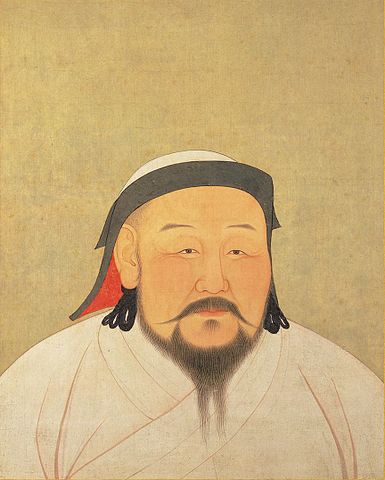 |
This is a file from the Wikimedia Commons. Information from its description page there is shown below.
Commons is a freely licensed media file repository. You can help.
|
Summary
| DescriptionYuanEmperorAlbumKhubilaiPortrait.jpg |
元世祖 忽必烈
English: A painting of Shizu, better known as Kublai Khan, as he would have appeared in the 1260s (although this painting is a posthumous one executed shortly after his death in February of 1294, by a Nepalese artist and astronomer Anige). The painting is done in the Chinese portrait style. It is now located in the National Palace Museum in Taipei, Taiwan; colors and ink on silk, 59.4 by 47 cm. Kublai's white robes reflect his desired and symbolic role as a religious Mongol shaman. On pages 66 to 67 of Morris Rossabi's Khubilai Khan: His Life and Times (paperback), he has this to say of the portrait and of a later portrait in 1280 of a hunt, also seen in the English Wikipedia article for Kublai Khan:
A Chinese portrait of him painted around this time [i.e. roughly the time of the rebellion of Li Tang and execution of Wang Wentong in 1262] shows a robust, determined man. He wears a simple white cloth garment; no silks or furs adorn his body. His black and white hat is hardly lavish, and his mustache and beard are trim and obviously cared for. Most important, the picture shows that Khubilai had not yet abandoned himself to sensual pleasures. Though certainly not gaunt, neither was he obese, as he became toward the end of his reign. Probably food, Chinese or any other kind, had not yet become a consuming passion; nor does he show any sign of being a heavy drinker, as later he would become. His alertness and robustness contrast sharply with his appearance in a painting executed in 1280. Two decades after assuming power in China, he had become grotesquely fat.
In the Artibus Asiae article The Portraits of Khubilai Khan and Chabi by Anige (1245-1306), a Nepali Artist at the Yuan Court, Anning Jing provides the history of this painting and that of Kublai's wife Chabi, painted by a Nepalese artist named Anige (also known as Araniko), who was a confidant of Kublai and was commissioned to oversee several public works projects as well. Portrait cropped out of a page from an album depicting several Yuan emperors (Yuandai di banshenxiang), now located in the National Palace Museum in Taipei (inv. nr. zhonghua 000324). Original size is 47 cm wide and 59.4 cm high. Paint and ink on silk. For the full page, see Image:YuanEmperorAlbumKhubilaiFull.jpg.
|
| Date |
1294 |
| Source |
Artdaily.org |
| Author |
Anige (also known as Araniko) of Nepal, an astronomer, engineer, painter, and confidant of Kublai Khan |
Licensing
This is a faithful photographic reproduction of an original two-dimensional work of art. The work of art itself is in the public domain for the following reason:
| Public domainPublic domainfalsefalse |
 |
This image (or other media file) is in the public domain because its copyright has expired.
This applies to Australia, the European Union and those countries with a copyright term of life of the author plus 70 years.
 You must also include a United States public domain tag to indicate why this work is in the public domain in the United States. Note that a few countries have copyright terms longer than 70 years: Mexico has 100 years, Colombia has 80 years, and Guatemala and Samoa have 75 years, Russia has 74 years for some authors. This image may not be in the public domain in these countries, which moreover do not implement the rule of the shorter term. Côte d'Ivoire has a general copyright term of 99 years and Honduras has 75 years, but they do implement the rule of the shorter term. You must also include a United States public domain tag to indicate why this work is in the public domain in the United States. Note that a few countries have copyright terms longer than 70 years: Mexico has 100 years, Colombia has 80 years, and Guatemala and Samoa have 75 years, Russia has 74 years for some authors. This image may not be in the public domain in these countries, which moreover do not implement the rule of the shorter term. Côte d'Ivoire has a general copyright term of 99 years and Honduras has 75 years, but they do implement the rule of the shorter term.
|
|
This file has been identified as being free of known restrictions under copyright law, including all related and neighboring rights.
|
The official position taken by the Wikimedia Foundation is that "faithful reproductions of two-dimensional public domain works of art are public domain, and that claims to the contrary represent an assault on the very concept of a public domain". For details, see Commons:When to use the PD-Art tag.
This photographic reproduction is therefore also considered to be in the public domain. Please be aware that depending on local laws, re-use of this content may be prohibited or restricted in your jurisdiction. See Commons:Reuse of PD-Art photographs.
{{ PD-Art}} template without parameter: please specify why the underlying work is public domain in both the source country and the United States
(Usage: {{PD-Art|1=|deathyear=|country=|date=}}, where parameter #1 can be PD-old-auto, PD-old-auto-1923, PD-old-100 or similar)
|
File usage
The following pages on Schools Wikipedia link to this image (list may be incomplete):
SOS Children's Villages has brought Wikipedia to the classroom. SOS Childrens Villages believes education is an important part of a child's life. That's why we ensure they receive nursery care as well as high-quality primary and secondary education. When they leave school, we support the children in our care as they progress to vocational training or higher education. Would you like to sponsor a child?



